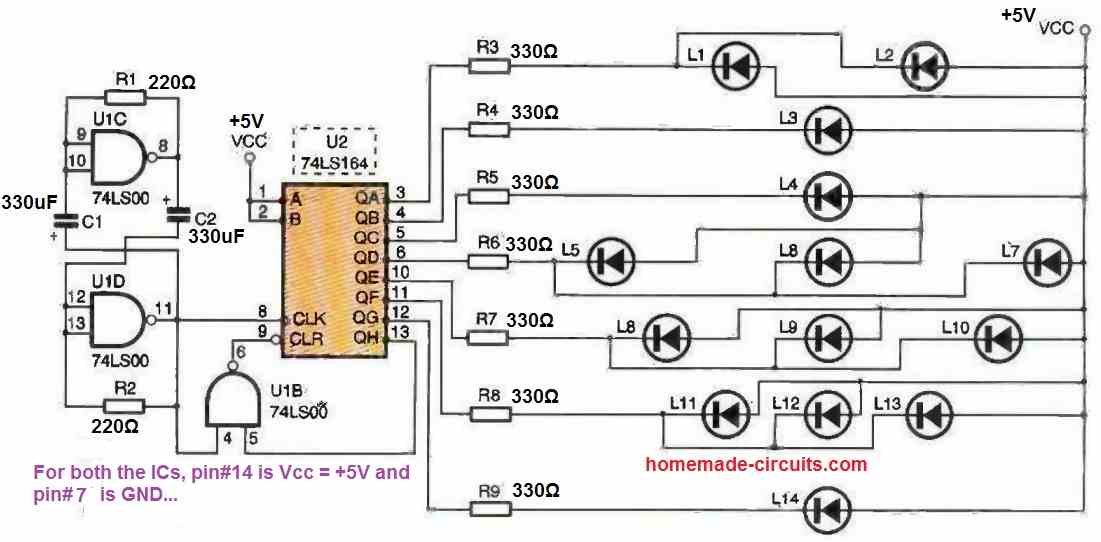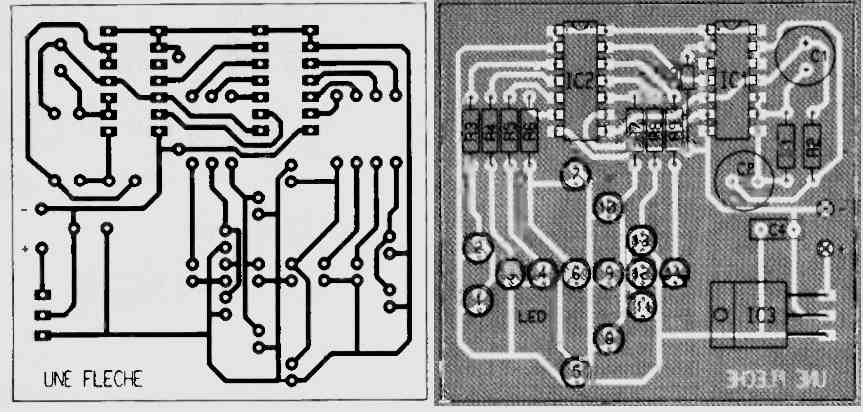The arrow-shaped LED direction indicator circuit utilizing the 74LS164 based IC and a configuration of 14 LEDs arranged in the shape of an arrow is a captivating and visually appealing project designed to create an eye-catching display.
This circuit is designed to illuminate the LEDs gradually, forming the shape of an arrow, and once the full arrow shape is achieved, the entire arrow will shut off, marking the completion of one cycle.
The 74LS164, a serial-in, parallel-out shift register IC that controls the LED lighting sequence, is at the heart of this design.
The shift register functions as a serial-to-parallel data converter, activating individual LEDs based on the data provided into the IC. This enables exact control of the LED states, which is suitable for this dynamic arrow-shaped indication.
The 14 LEDs arranged in the shape of an arrow provide an artistic dimension to the circuit, making it an appealing visual indication for a variety of applications.
The LEDs' step-by-step lighting provides a fluid motion that attracts attention and may be utilized for directional signals or as an appealing visual display in many technological applications.
Circuit Description
The following figure presents the entire setup for the LED direction indicator circuit.

An oscillator drives the shift register. The outputs of the shift register control the LEDs.
The last output of the shift register controls the reset (RAZ). Whenever the CLK input of the shift register receives a rising edge, it copies the value from the DATA input to Q1, the value of Q1 goes to Q2, and so on.
The RAZ sets the outputs of the shift register to zero, which turns on all the LEDs.
After a reset, the next pulse on CLK sets the Q1 output to 1, turning off the first two LEDs, L1 and L2.
The other LEDs remain on since the shifted values are all 0. On the second pulse after a reset, we copy DATA into Q1, making it 1, and Q1 into Q2, which is also 1. The other shifted outputs remain unchanged.
Now, we have Q1 and Q2 set to 1, turning off L3 in addition to L1 and L2 from the previous phase.
This pattern continues until Q8. When Q8 becomes 1, it sets CLR to 0 through a NOT AND gate, which resets all the outputs to zero, turning off all the LEDs. Then, the cycle starts again.
PCB Assembly

It is simple and requires little explanation. Some pads are close together, so be careful during the operations of assembling and soldering.
For the aesthetics of the setup, it is imperative to align the LEDs at the same height.
To achieve this, you can create a cardboard template of the appropriate height that you will place between the diode and the printed circuit board during soldering.
A 7805 IC regulator can be used to generate the intended voltage (5V). The power supply can be provided by a 7 V wall adapter or a 9 V battery.
Final Note
To produce a smooth arrow formation throughout the illumination process, it is critical in this project to maintain appropriate LED alignment and consistent height.
The circuit's cyclic nature adds an element of interaction, as the arrow will glow step by step until the complete arrow shape is created, and then the entire arrow will shut off, ready to begin a new cycle.
Because of the ease of wiring, the adaptability of the 74LS164 IC, and the compelling arrow-shaped LED arrangement, this circuit is an interesting and enjoyable electronics project for hobbyists, students, and enthusiasts alike.
Need Help? Please Leave a Comment! We value your input—Kindly keep it relevant to the above topic!